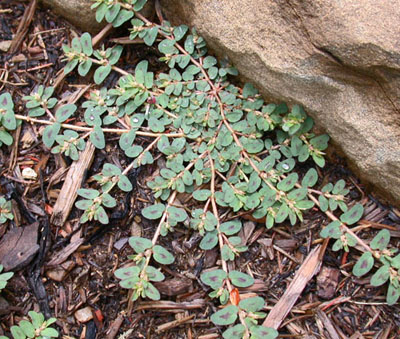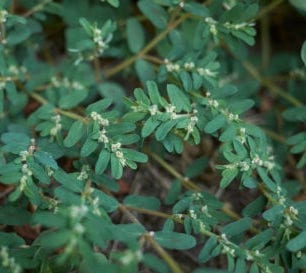To Spurge or Not to Spurge
By Carolyn R. Casey, Fairfax Master Gardener
 While working in my garden, I noticed a strange looking plant that had all of a sudden popped up in my garden and lawn that appeared to be flat and circular like a green pancake. I did some research and have determined that it is be a common weed known as Prostrate Spurge, a fast growing annual weed that germinates from seed in June and July.
While working in my garden, I noticed a strange looking plant that had all of a sudden popped up in my garden and lawn that appeared to be flat and circular like a green pancake. I did some research and have determined that it is be a common weed known as Prostrate Spurge, a fast growing annual weed that germinates from seed in June and July.
Prostrate Spurge (Euphorbia prostrata) previously belonged to the genus Chamaesyce before it was reclassified. Chamaesyce is Latin for “low growing on the ground.” This old name was used in John Gerard’s 1633 edition of The Herbal Botanists. Recently, the spurges have been placed into the new genus, Euphorbia.
This annual weed forms a mat that grows close to the ground and is typically 1 or 2 inches tall (2-5 cm) and approximately 3 feet wide (1 m). It is a dense mass of slender multibranched stems that come from a single taproot. It can be found growing in Canada, the United States and Mexico.
Its leaves are oval and opposite from each other on pinkish hairy stems and are about one third of an inch long. Spurge leaves are green, gray green or maroon and may have a maroon blotch. Spurges have a milky sap, and the stems and leaves ooze this when cut. They are toxic to some animals. The sap is being studied as a treatment for skin cancer.
Prostrate Spurge likes full sun, good drainage and will not grow in the shade. It grows in a variety of soil and climate conditions including highly compacted soils, clay, sand and shallow rocky areas. It also grows in weakened turfgrass and landscapes. Because of its taproot, it does not compete with other plants for water and nutrients.

Small flowers on spurge
It has very small greenish white flowers that have four to five petals. The flowers are at the upper stem, and both male and female flowers are in each cluster. It blooms from July to September and produces copious amounts of seeds in its life. In the fall, it forms a small black or brown copper fruit that is a fat three-lobed, three-seeded pod with stiff hairs on its surface.
It reproduces from seeds that survive several years in the soil until conditions are right for them to germinate. The seeds germinate when temperatures are 75 to 85 degrees F (23-29 C) and may germinate at 60 degrees F (15 C) or as high as 100 degrees F (37 C). It may produce seeds five weeks after it germinates.
Prostrate Spurge’s taproot makes it easy to hand weed and pull out the root. I simply run my gloved hand under the branches up to the tap root and pull. This way I am able to pull up the spurge plant and the root. Gloves should be worn when hand weeding spurge since the sap is toxic and can irritate your skin. If parts of the spurge plant are ingested, it may cause nausea or vomiting.
Mulching in the spring helps to prevent the spurge seeds for germinating. Synthetic weed barriers block out the sun and will help to prevent seed germination. Mowing does not help control spurge because it grows so close to the ground.
To control spurge in turf, maintain a healthy and thick lawn with proper mowing, fertilizing and watering. Control spurge in the home vegetable garden with the use of soil solarization, mulch and early cultivation. Soil solarization is covering the soil with sheets of clear plastic for four to six weeks in the summer. This works best when temperatures are 90 degrees F and above. This reduces the number of weed seeds in an area and needs to be done prior to planting.
It is hard to distinguish Prostrate Spurge from other species of spurge especially Spotted Spurge. Some believe the two plants are the same species. A characteristic used to identify both species is the small maroon blotch located at the mid-vein or base of Spotted Spurge leaves. Prostrate Spurge does not have the blotch on its leaves. The leaves are also shorter and are more rounded at the tips. Another difference between Prostrate Spurge and Spotted Spurge is that the leaves of Spotted Spurge are typically a darker color, and the nodes do not form roots when they come in contact with the soil.
Types of Prostrate Spurge
Spotted Spurge (Euphorbia maculata) is a prostrate summer annual. It has dark green leaves that grow opposite each other that have maroon spots in the middle of the center veins. The blotches camouflage the spurge, making it hard to discern it from turf. It has hairy flowers, fruit, stems and leaves. Broken stems and branches ooze a milky poisonous sap that is an eye and skin irritant. It also has a taproot that may extend over 24 inches long into the soil.

Spotted spurge and prostate spurge leaves
It propagates from seed, and the seeds are hydrophilic, meaning that the seeds can attach to surfaces that are wet. The fruit is a three-sectioned seed pod that may be 1/16 inch (1 mm) or less. The pod contains one seed that is about 1/25 inch long. It has very small pinkish white flowers grouped in tiny flowerlike clusters called cyathia that form where the leaf joins the stem. The cyathia is the characteristic inflorescence of the spurges, resembling a single flower. It consists of a cup-shaped involucre (whorl) of fused bracts enclosing several greatly reduced male flowers and a single female flower. It may produce these flowers in three to four weeks after it emerges.
Spotted Spurge reduces the growth of desirable plants and decreases the consistency and condition of turf. It also creates a habitat for unwanted insects. It is an intermediate host for fungal diseases of cultivated crops, and its seeds attract ants. Spotted Spurge is toxic and can kill sheep grazing in pastures where it is the predominant weed. Sheep that have eaten as little as 0.62 percent of their body weight in Spotted Spurge have been known to die within a few hours.
Creeping Spurge (Euphorbia serpens) is a prostrate spurge with green leaves and no markings on them. It differs from other Prostrate Spurges in that it has smaller more rounded leaves and does not have hairs on the stems. It also has the ability to generate new plants vegetatively by creating roots along the nodes. It blooms in the summer and early fall with flowers that are green or white.
Garden Spurge (Euphorbia hirta) is a prostrate to ascending spurge. It has uneven leaves and a large seedhead. There are two forms of this spurge: one has small light green leaves and one has larger leaves that are often maroon. It grows 1 to 2 feet high (0.3-0.6 m) and 1 to 2 feet wide. The flowers are greenish-white with red, are without petals and are unisexual. The flowers bloom in the fall and again in summer. Its leaves are green and red-burgundy. The fruit is a gold yellow capsule that can produce 3,000 oblong four-sided seeds.
Please refer to Sections 4 and 5 in the 2021 Pest Management Guide for products that can be used to control spurge by a homeowner or professionals.
Resources
• Euphorbia prostrata, Elisabeth Meyer, North Carolina Extension Gardener Plant Toolbox
• Plant of the Week: Prostrate Spurge, Gerald Klingaman, University of Arkansas Division of Agriculture
Research and Extension
• Spotted Spurge and Other Spurges, R.H. Molinar, D.W. Cudney, C.L. Elmore, A. Sanders, University of
California Integrated Pest Management Program
• Prostrate Spurge, Aaron Patton, Leslie Beck, Department of Horticulture and Landscape Architecture,
Purdue University
• Euphorbia hirta, Elisabeth Meyer, North Carolina Extension Gardener Toolbox
• Spurge, Shawn Askew, Section 5, Lawn Weeds, 2021 Pest Management Guide, Virginia Cooperative
Extension